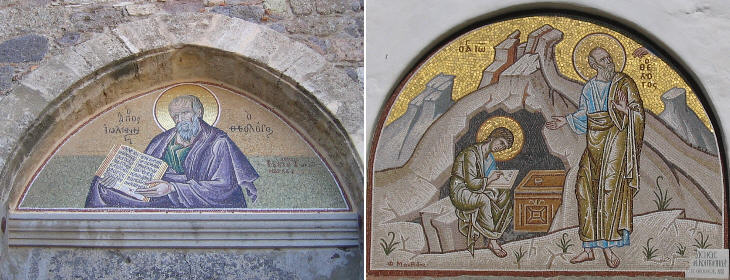  What's New! Detailed Sitemap All images © by Roberto Piperno, owner of the domain. Write to romapip@quipo.it. Text edited by Rosamie Moore. Page added in November 2006. |
  Patmo (Patmos) Patmo (Patmos)
Key dates: 1190 The Byzantine Emperor Alexis I Comnenus offers the island to the blessed Christodoulos to found a monastery 1453 The population of the island is increased by refugees from Constantinople 1537 The Ottomans impose a yearly tax on the monastery 1669 Refugees from Candia resettle in the island 1912-1943 Italian rule
The island of Patmos is very small (only 13 square miles), but it is well known for its mention in the Book of Revelation (Apocalypse of John): the tradition identifies this John with St John the Evangelist who was exiled to Patmos.
Chora (town) is located on a hill in the central part of the island and is dominated by the shape of the monastery, especially now that all the houses are painted white.
The external appearance of the monastery is very much that of a fortress: it was initially built in the XIth century but its fortifications were strengthened in the XVth and in the XVIIth centuries.
The monastery is structured around a central courtyard which was modified several times and was thoroughly redesigned in 1698.
The narthex (porch) of the main church is entirely decorated with frescoes portraying in general episodes of the life of St John the Evangelist including the saint defeating the devils who tempted him (for another Orthodox monastery with many frescoes click here).
In addition to the main monastery at the top of the hill there is a smaller monastery at the cave where St John the Evangelist wrote the Apocalypse.
The view from the monastery and from the cave is so peaceful that Patmos seems the most unlikely place to write a book about the end of the world.
The religious atmosphere of Patmos is emphasized by many churches surrounding the monastery.
Today there is a tendency to emphasize the "cycladic" appearance of the towns in the Aegean islands: the streets of Kritika (the quarter where the refugees from Crete resettled) and Alotina (where the refugees from Constantinople resettled) would gain if they were given back their medieval atmosphere by uncovering the stone structure of their buildings. Move to Introductory page on the Venetian Fortresses Introductory page on the Fortresses of the Knights of Rhodes Introductory page on the Fortresses of the Sultans Clickable Map of the Ionian and Aegean Seas with links to other locations covered in this website (opens in a separate window) |








